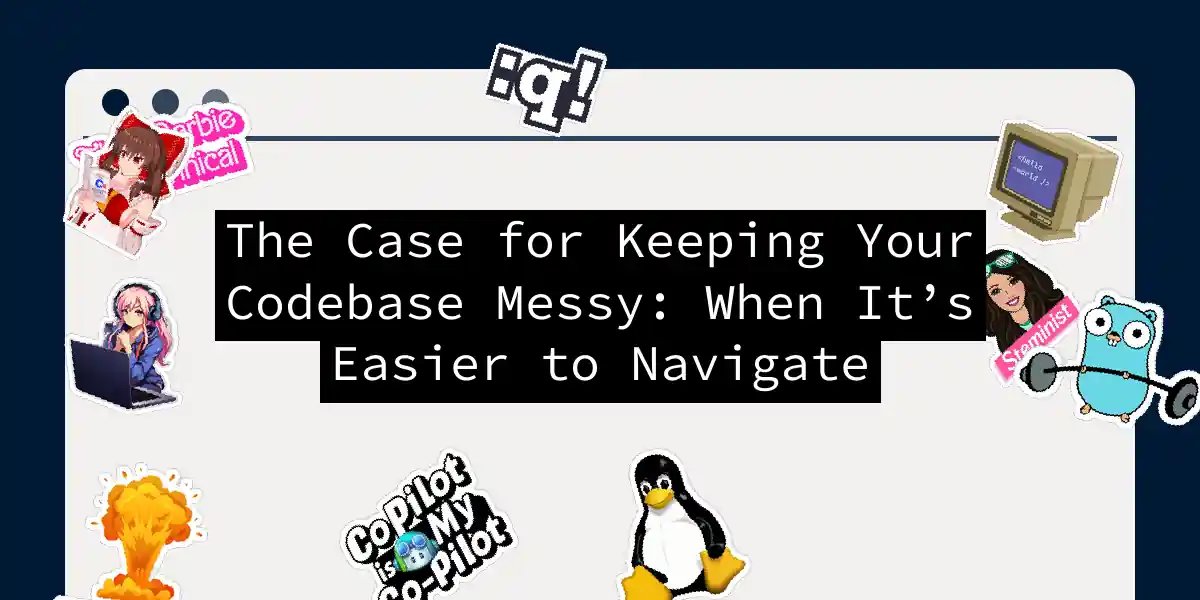We’ve all heard the sermons about pristine codebases. “Clean code is maintainable code!” they chant. “A place for everything and everything in its place!” they lecture. But what if I told you your codebase might be healthier with a dash of chaos? Let’s explore why sometimes controlled messiness beats architectural asceticism.
Code Tetris: When Organization Fails
Consider this C++ memory management snippet from a physics simulation project:
int sz = 100;
int* p = (int*) malloc(sizeof(int) * sz);
int count = 0;
// ... 200 lines of particle collision calculations ...
if (count == sz)
p = (int*) realloc(p, sizeof(int) * sz * 2);
p[count++] = x;
This code isn’t winning beauty contests. No RAII. No smart pointers. But in context, it worked beautifully for rapid prototyping of fluid dynamics. The team eventually wrapped it in a ParticleBuffer class… after proving the concept with Nobel Prize-winning research using this exact “messy” version.
The Abstraction Trap
I once spent three weeks creating the perfect AbstractFactoryPipelineManager only to discover:
- The project timeline moved up by 6 months
- Our use case changed completely
- My beautiful abstraction now supported exactly zero active code paths The lesson? Sometimes duct tape beats architecture blueprints.
When to Embrace the Chaos
Strategy for productive messiness:
- Identify Temporary Features
(That marketing experiment? The holiday promo module? Let them be ugly) - Prioritize Velocity
Your startup’s runway cares more about working code than SOLID principles - Contain the Mess
Create “quarantine zones” with// TEMPORARYcomments andexperimental/directories
The Navigation Paradox
Ironically, some “messy” codebases become more navigable through organic growth. I recently worked with a 10-year-old codebase where:
- All database calls lived in
/lib/db-spaghetti - UI components were in
/views/old-new-experimental - The “utils” folder had 47 files including
helpers_final_v2.cYet engineers could: - Fix production issues in under 15 minutes
- Onboard new hires in 2 days (“Just follow the crumb trail!”)
- Make changes without fear of breaking distant systems Compare this to a hyper-modularized codebase where simple changes require:
- Updating 17 interfaces
- Modifying 9 configuration files
- Appeasing the Unit Test Coverage Gods
The Art of Strategic Mess-Making
Survival kit for messy code warriors:
- The 3-Question Test
Ask: “Will cleaning this help us ship faster?”
“Do multiple engineers need to modify it?”
“Is this causing active bugs?” - Document the Why
That ugly regex deserves a comment:// Matches EU license plates except Luxembourg 2023 exception - Schedule ‘Spring Cleaning’ Sprints
Our team does “Code Archaeology Fridays” with beer and bug hunting
Embrace Your Inner Code Janitor
The software industry’s dirty secret: entropy is inevitable. Like a teenager’s bedroom, codebases naturally tend toward disorder. The skill lies in knowing which socks to leave on the floor and which moldy pizza boxes to remove immediately. Next time you’re tempted to be the Marie Kondo of programming, ask: “Does this abstraction spark joy… or just create more work?” Sometimes, the most maintainable code is the kind that gets out of your way and lets you ship. What’s your messiest code victory? Share your war stories in the comments - the most creatively chaotic example wins a year’s supply of virtual shame… and my undying respect.
